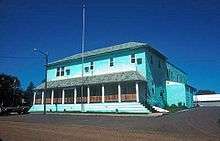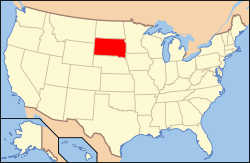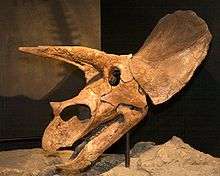Corson County, South Dakota
| Corson County, South Dakota | |
|---|---|
 Corson County Courthouse in McIntosh, South Dakota in 1993. This building was destroyed by fire on April 10, 2006. | |
 Location in the U.S. state of South Dakota | |
 South Dakota's location in the U.S. | |
| Founded | 1909 |
| Named for | Dighton Corson |
| Seat | McIntosh |
| Largest city | McLaughlin |
| Area | |
| • Total | 2,530 sq mi (6,553 km2) |
| • Land | 2,470 sq mi (6,397 km2) |
| • Water | 60 sq mi (155 km2), 2.4% |
| Population (est.) | |
| • (2015) | 4,197 |
| • Density | 1.6/sq mi (1/km²) |
| Congressional district | At-large |
| Time zone | Mountain: UTC-7/-6 |
| Website |
corson |

Corson County is a county located in the U.S. state of South Dakota. As of the 2010 census, the population was 4,050.[1] Its county seat is McIntosh.[2] The county was named for Dighton Corson, a native of Maine, who came to the Black Hills in 1876, and in 1877 began practicing law at Deadwood.
The county is encompassed within the Standing Rock Indian Reservation, which extends into North Dakota. The Lakota people reside primarily in the South Dakota part of the reservation; the Yanktonai and Dakota live in that part in North Dakota. The Grand River, a tributary of the Missouri River, runs through the reservation.
Geography
According to the U.S. Census Bureau, the county has a total area of 2,530 square miles (6,600 km2), of which 2,470 square miles (6,400 km2) is land and 60 square miles (160 km2) (2.4%) is water.[3] It is the fifth-largest county in South Dakota by area. The entire county lies within the Standing Rock Indian Reservation, which also includes Sioux, Ziebach, and Dewey counties.
Major highways
 U.S. Highway 12
U.S. Highway 12 South Dakota Highway 20
South Dakota Highway 20 South Dakota Highway 63
South Dakota Highway 63 South Dakota Highway 65
South Dakota Highway 65 South Dakota Highway 1806
South Dakota Highway 1806
Adjacent counties
- Sioux County, North Dakota - north
- Adams County, North Dakota - northwest
- Campbell County - east
- Walworth County - southeast
- Dewey County - south
- Ziebach County - southwest
- Perkins County - west
National protected area
Demographics
| Historical population | |||
|---|---|---|---|
| Census | Pop. | %± | |
| 1910 | 2,929 | — | |
| 1920 | 7,249 | 147.5% | |
| 1930 | 9,535 | 31.5% | |
| 1940 | 6,755 | −29.2% | |
| 1950 | 6,168 | −8.7% | |
| 1960 | 5,798 | −6.0% | |
| 1970 | 4,994 | −13.9% | |
| 1980 | 5,196 | 4.0% | |
| 1990 | 4,195 | −19.3% | |
| 2000 | 4,181 | −0.3% | |
| 2010 | 4,050 | −3.1% | |
| Est. 2015 | 4,197 | [4] | 3.6% |
| U.S. Decennial Census[5] 1790-1960[6] 1900-1990[7] 1990-2000[8] 2010-2015[1] | |||
2000 census
As of the census[9] of 2000, there were 4,181 people, 1,271 households, and 949 families residing in the county. The population density was 1.7 people per square mile (0.7/km²). There were 1,536 housing units at an average density of 0.6 per square mile (0.2/km²). The racial makeup of the county was 60.80% Native American, 37.19% White, 0.10% Black or African American, 0.05% Asian, 0.22% from other races, and 1.65% from two or more races. 2.13% of the population were Hispanic or Latino of any race. 27.3% were of German ancestry.
There were 1,271 households out of which 38.3% had children under the age of 18 living with them, 46.8% were married couples living together, 19.7% had a female householder with no husband present, and 25.3% were non-families. 22.1% of all households were made up of individuals and 10.0% had someone living alone who was 65 years of age or older. The average household size was 3.29 and the average family size was 3.82.
In the county, the population was spread out with 36.9% under the age of 18, 9.8% from 18 to 24, 24.3% from 25 to 44, 18.5% from 45 to 64, and 10.5% who were 65 years of age or older. The median age was 28 years. For every 100 females there were 102.0 males. For every 100 females age 18 and over, there were 100.8 males.
The median income for a household in the county was $20,654, and the median income for a family was $23,889. Males had a median income of $22,717 versus $19,609 for females. The per capita income for the county was $8,615. About 32.80% of families and 41.00% of the population were below the poverty line, including 48.60% of those under age 18 and 32.70% of those age 65 or over. The county's per-capita income makes it one of the poorest counties in the United States.
2010 census
As of the 2010 United States Census, there were 4,050 people, 1,260 households, and 939 families residing in the county.[10] The population density was 1.6 inhabitants per square mile (0.62/km2). There were 1,540 housing units at an average density of 0.6 per square mile (0.23/km2).[11] The racial makeup of the county was 67.0% American Indian, 29.7% white, 0.3% Asian, 0.1% black or African American, 0.3% from other races, and 2.6% from two or more races. Those of Hispanic or Latino origin made up 2.6% of the population.[10] In terms of ancestry,[12]
Of the 1,260 households, 45.6% had children under the age of 18 living with them, 40.6% were married couples living together, 21.9% had a female householder with no husband present, 25.5% were non-families, and 22.7% of all households were made up of individuals. The average household size was 3.21 and the average family size was 3.73. The median age was 29.7 years.[10]
The median income for a household in the county was $30,877 and the median income for a family was $36,500. Males had a median income of $32,037 versus $23,167 for females. The per capita income for the county was $13,359. About 24.1% of families and 35.1% of the population were below the poverty line, including 46.7% of those under age 18 and 16.9% of those age 65 or over.[13]
Communities

Cities
- McIntosh (county seat)
- McLaughlin
Town
Census-designated places
Unincorporated communities
Townships
The county is divided into eleven townships:
- Custer
- Delaney
- Lake
- Mission
- Pleasant Ridge
- Prairie View
- Ridgeland
- Rolling Green
- Sherman
- Wakpala
- Watauga
Unorganized territories
The county contains four areas of unorganized territory:
- Central Corson
- Lemmon No. 2
- Northeast Corson
- West Corson
Notable residents
See also
References
- 1 2 "State & County QuickFacts". United States Census Bureau. Retrieved November 26, 2013.
- ↑ "Find a County". National Association of Counties. Archived from the original on 2011-05-31. Retrieved 2011-06-07.
- ↑ "2010 Census Gazetteer Files". United States Census Bureau. August 22, 2012. Retrieved March 23, 2015.
- ↑ "County Totals Dataset: Population, Population Change and Estimated Components of Population Change: April 1, 2010 to July 1, 2015". Retrieved July 2, 2016.
- ↑ "U.S. Decennial Census". United States Census Bureau. Archived from the original on May 11, 2015. Retrieved March 23, 2015.
- ↑ "Historical Census Browser". University of Virginia Library. Retrieved March 23, 2015.
- ↑ Forstall, Richard L., ed. (March 27, 1995). "Population of Counties by Decennial Census: 1900 to 1990". United States Census Bureau. Retrieved March 23, 2015.
- ↑ "Census 2000 PHC-T-4. Ranking Tables for Counties: 1990 and 2000" (PDF). United States Census Bureau. April 2, 2001. Retrieved March 23, 2015.
- ↑ "American FactFinder". United States Census Bureau. Archived from the original on 2013-09-11. Retrieved 2011-05-14.
- 1 2 3 "DP-1 Profile of General Population and Housing Characteristics: 2010 Demographic Profile Data". United States Census Bureau. Retrieved 2016-03-11.
- ↑ "Population, Housing Units, Area, and Density: 2010 - County". United States Census Bureau. Retrieved 2016-03-11.
- ↑ "DP02 SELECTED SOCIAL CHARACTERISTICS IN THE UNITED STATES – 2006-2010 American Community Survey 5-Year Estimates". United States Census Bureau. Retrieved 2016-03-11.
- ↑ "DP03 SELECTED ECONOMIC CHARACTERISTICS – 2006-2010 American Community Survey 5-Year Estimates". United States Census Bureau. Retrieved 2016-03-11.
 |
Sioux County, North Dakota |  | ||
| Perkins County | |
Campbell County | ||
| ||||
| | ||||
| Ziebach County | Dewey County | Walworth County |
Coordinates: 45°43′N 101°11′W / 45.72°N 101.18°W